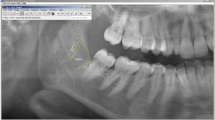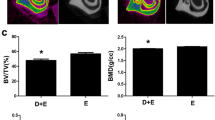Abstract
The mechanism regulating the divergent healing processes following tooth replantation is unclear. This study clarifies the relationship between the healing pattern, the time taken for tooth replantation, and the influence of occlusal force. We investigated the pulpal healing process after tooth replantation by immunohistochemistry for 5-bromo-2′-deoxyuridine and nestin and by histochemistry for tartrate-resistant acid phosphatase. The upper right first molar of 3-week-old mice was extracted and repositioned in the original socket immediately or 30 min to 6 h after the operation. We divided the animals into a non-occluded group in which the lower right first molar was extracted and an occluded group without extraction of the counterpart tooth. In control teeth (upper left first molar), the periphery of the coronal dental pulp showed intense nestin-positive reaction. Tooth replantation weakened the nestin-positive reaction in the pulp tissue. On postoperative days 5–7, tubular dentin formation commenced next to preexisting dentin in which nestin-positive odontoblast-like cells were arranged in successful cases. In other cases, bone-like tissue formation occurred in the pulp chamber until day 14. The ratio of tertiary dentin formation was significantly higher in the non-occluded group. The intentionally prolonged time for the completion of tooth replantation induced bone-like tissue formation, expanded inflammatory reaction, or fibrous tissue formation in pulp tissue. Thus, the lack of a proper oxygenated medium is probably decisive for the survival of odontoblast-lineage cells, and occlusal force during and/or after operation worsens the fate of these cells.







Similar content being viewed by others
References
About I, Mitsiadis TA (2001) Molecular aspects of tooth pathogenesis and repair: in vivo and in vitro models. Adv Dent Res 15:59–62
About I, Laurent-Maquin D, Lendahl U, Mitsiadis TA (2000) Nestin expression in embryonic and adult human teeth under normal and pathological conditions. Am J Pathol 157:287–295
Andreasen JO, Borum MK, Jacobsen HL, Andreasen FM (1995) Replantation of 400 avulsed permanent incisors. 2. Factors related to pulpal healing. Endod Dent Traumatol 11:59–68
Artavanis-Tsakonas S, Rand MD, Lake RJ (1999) Notch signaling: cell fate control and signal integration in development. Science 284:770–776
Bonucci E, Nanci A (2001) Alkaline phosphatase and tartrate-resistant acid phosphatase in osteoblasts of normal and pathologic bone. Ital J Anat Embryol 106:129–133
Byers MR, Kvinnsland I, Bothwell M (1992) Analysis of low affinity nerve growth factor receptor during pulpal healing and regeneration of myelinated and unmyelinated axons in replanted teeth. J Comp Neurol 326:470–484
Chai Y, Jiang X, Ito Y, Bringas P Jr, Han J, Rowitch DH, Soriano P, McMahon AP, Sucov HM (2000) Fate of the mammalian cranial neural crest during tooth and mandibular morphogenesis. Development 127:1671–1679
Frisen J, Lendahl U (2001) Oh no, Notch again! Bioessays 23:3–7
Goldberg M, Smith AJ (2004) Cells and extracellular matrices of dentin and pulp: a biological basis for repair and tissue engineering. Crit Rev Oral Biol Med 15:13–27
Gronthos S, Mankani M, Brahim J, Robey PG, Shi S (2000) Postnatal human dental pulp stem cells (DPSCs) in vitro and in vivo. Proc Natl Acad Sci USA 97:13625–13630
Gronthos S, Brahim J, Li W, Fisher LW, Cherman N, Boyde A, DenBesten P, Robey PG, Shi S (2002) Stem cell properties of human dental pulp stem cells. J Dent Res 81:531–535
Iohara K, Zheng L, Ito M, Tomokiyo A, Matsushita K, Nakashima M (2006) Side population cells isolated from porcine dental pulp tissue with self-renewal and multipotency for dentinogenesis, chondrogenesis, adipogenesis, and neurogenesis. Stem Cells 24:2493–2503
Kvinnsland I, Heyeraas KJ, Byers MR (1991) Regeneration of calcitonin gene-related peptide immunoreactive nerves in replanted rat molars and their supporting tissues. Arch Oral Biol 36:815–826
Lossdörfer S, Gotz W, Jager A (2002) Immunohistochemical localization of receptor activator of nuclear factor kappaB (RANK) and its ligand (RANKL) in human deciduous teeth. Calcif Tissue Int 71:45–52
Magloire H, Joffre A, Bleicher F (1996) An in vitro model of human dental pulp repair. J Dent Res 75:1971–1978
Matsuo K, Ray N (2004) Osteoclasts, mononuclear phagocytes, and c-Fos: new insight into osteoimmunology. Keio J Med 53:78–84
Mitsiadis TA, Fried K, Goridis C (1999) Reactivation of Delta-Notch signaling after injury: complementary expression patterns of ligand and receptor in dental pulp. Exp Cell Res 246:312–318
Mitsiadis TA, Romeas A, Lendahl U, Sharpe PT, Farges JC (2003) Notch2 protein distribution in human teeth under normal and pathological conditions. Exp Cell Res 282:101–109
Miura M, Gronthos S, Zhao M, Lu B, Fisher LW, Robey PG, Shi S (2003) SHED: stem cells from human exfoliated deciduous teeth. Proc Natl Acad Sci USA 100:5807–5812
Nakakura-Ohshima K, Watanabe J, Kenmotsu S, Ohshima H (2003) Possible role of immunocompetent cells and the expression of heat shock protein-25 in the process of pulpal regeneration after tooth injury in rat molars. J Electron Microsc 52:581–591
Nakasone N, Yoshie H, Ohshima H (2006) An immunohistochemical study of the expression of heat-shock protein-25 and cell proliferation in the dental pulp and enamel organ during odontogenesis in rat molars. Arch Oral Biol 51:378–386
Nanci A (2003) Ten Cate’s oral histology: development, structure, and formation, 6th ed. Mosby, St Louis, pp 397–416
Ohshima H, Yoshida S (1992) The relationship between odontoblasts and pulp capillaries in the process of enamel- and cementum-related dentin formation in rat incisors. Cell Tissue Res 268:51–63
Ohshima H, Ajima H, Kawano Y, Nozawa-Inoue K, Wakisaka S, Maeda T (2000) Transient expression of heat shock protein (HSP)-25 in the dental pulp and enamel organ during odontogenesis in the rat incisor. Arch Histol Cytol 63:381–395
Ohshima H, Nakakura-Ohshima K, Yamamoto H, Maeda T (2001) Alteration in the expression of heat shock protein (HSP)-25-immunoreactivity in the dental pulp of rat molars following tooth replantation. Arch Histol Cytol 64:425–437
Ohshima H, Nakakura-Ohshima K, Maeda T (2002) Expression of heat-shock protein 25 immunoreactivity in the dental pulp and enamel organ during odontogenesis in the rat molar. Connect Tissue Res 43:220–223
Ohshima H, Nakakura-Ohshima K, Takeuchi K, Hoshino M, Takano Y, Maeda T (2003) Pulpal regeneration after cavity preparation, with special reference to close spatio-relationships between odontoblasts and immunocompetent cells. Microsc Res Tech 60:483–490
Ogasawara T, Yoshimine Y, Kiyoshima T, Kobayashi I, Matsuo K, Akamine A, Sakai H (2004) In situ expression of RANKL, RANK, osteoprotegerin and cytokines in osteoclasts of rat periodontal tissue. J Periodontal Res 39:42–49
Ogawa R, Saito C, Jung HS, Ohshima H (2006) Capacity of dental pulp differentiation after tooth transplantation. Cell Tissue Res 326:715–724
Okiji T, Kawashima N, Kosaka T, Matsumoto A, Kobayashi C, Suda H (1992) An immunohistochemical study of the distribution of immunocompetent cells, especially macrophages and Ia antigen-expressing cells of heterogeneous populations, in normal rat molar pulp. J Dent Res 71:1196–1202
Ruch JV, Lesot H, Begue-Kirn C (1995) Odontoblast differentiation. Int J Dev Biol 39:51–68
Rungvechvuttivittaya S, Okiji T, Suda H (1998) Responses of macrophage-associated antigen-expressing cells in the dental pulp of rat molars to experimental tooth replantation. Arch Oral Biol 43:701–710
Sheela Rani CS, MacDougall M (2000) Dental cells express factors that regulate bone resorption. Mol Cell Biol Res Commun 3:145–152
Shi S, Gronthos S (2003) Perivascular niche of postnatal mesenchymal stem cells in human bone marrow and dental pulp. J Bone Miner Res 18:696–704
Shimizu A, Nakakura-Ohshima K, Noda T, Maeda T, Ohshima H (2000) Responses of immunocompetent cells in the dental pulp to replantation during the regeneration process in rat molars. Cell Tissue Res 302:221–233
Smith AJ (2002) Dentin formation and repair. In: Hargreaves KM, Goodis HE (eds) Seltzer and Bender’s dental pulp. Quintessence Publishing, Chicago, pp 41–62
Smith AJ, Lesot H (2001) Induction and regulation of crown dentinogenesis: embryonic events as a template for dental tissue repair? Crit Rev Oral Biol Med 12:425–437
Smith CE, Warshawsky H (1975) Cellular renewal in the enamel organ and the odontoblast layer of the rat incisor as followed by radioautography using 3H-thymidine. Anat Rec 183:523–561
Smith CE, Warshawsky H (1976) Movement of entire cell populations during renewal of the rat incisor as shown by radioautography after labelling with 3H-thymidine. The concept of a continuously differentiating cross-sectional segment. Am J Anat 145:225–259
Tate Y, Yoshiba K, Yoshiba N, Iwaku M, Okiji T, Ohshima H (2006) Odontoblast responses to GaAlAs laser irradiation in rat molars: an experimental study using heat-shock protein-25-immunohistochemistry. Eur J Oral Sci 114:50–57
Terling C, Rass A, Mitsiadis TA, Fried K, Lendahl U, Wroblewski J (1995) Expression of the intermediate filament nestin during rodent tooth development. Int J Dev Biol 39:947–956
Tsukamoto-Tanaka H, Ikegame M, Takagi R, Harada H, Ohshima H (2006) Histochemical and immunocytochemical study on hard tissue formation in dental pulp during the healing process after tooth replantation in rat molars. Cell Tissue Res 325:219–229
Tziafas D, Smith AJ, Lesot H (2000) Designing new treatment strategies in vital pulp therapy. J Dent 28:77–92
Yamamura T (1985) Differentiation of pulpal cells and inductive influences of various matrices with reference to pulpal wound healing. J Dent Res 64:530–540
Acknowledgements
We are grateful to Mr. Shin-ichi Kenmotsu for his technical assistance.
Author information
Authors and Affiliations
Corresponding author
Additional information
This work was supported in part by KAKENHI (B) from MEXT, Japan (no. 16390523 to H.O.) and by the Japan-Korea Joint Research Project from JSPS and KOSEF.
Rights and permissions
About this article
Cite this article
Hasegawa, T., Suzuki, H., Yoshie, H. et al. Influence of extended operation time and of occlusal force on determination of pulpal healing pattern in replanted mouse molars. Cell Tissue Res 329, 259–272 (2007). https://doi.org/10.1007/s00441-007-0424-4
Received:
Accepted:
Published:
Issue Date:
DOI: https://doi.org/10.1007/s00441-007-0424-4




